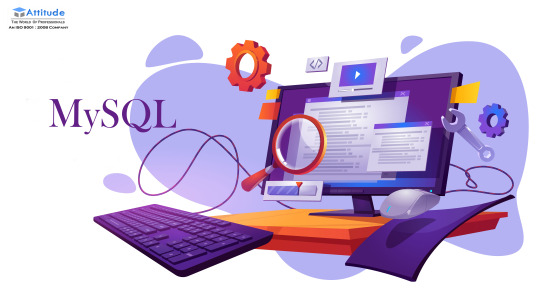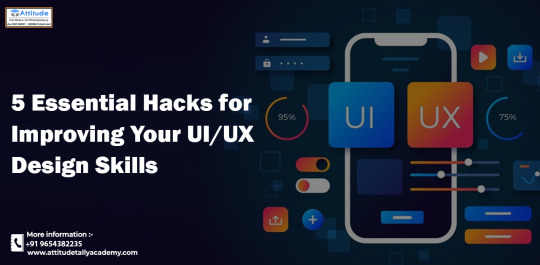#attitudeacademy
Text
Rise to the Top: Elevate Your Brand with Proven Digital Marketing Tactics

🚀 Elevate your brand with the power of proven digital marketing tactics! 🌐 In the dynamic online landscape, social bookmarking is a game-changer. 📚 Bookmark our blog on "Rise to the Top" for insights on SEO, content marketing, and social media strategies. 🎯 Target audience engagement is key! 📈 Discover how integrating keywords like "digital marketing tactics," "customer engagement," and "target audience" can skyrocket your online presence. 🔍🔗 Stay ahead in the competition – bookmark now and unlock the path to digital success! 💡✨
2 notes
·
View notes
Text
"Mastering Business Intelligence: Elevate Your Insights at Yamuna Vihar Attitude Academy"
Introduction
In today's data-driven world, the role of Business Intelligence (BI) has become paramount for organizations looking to make informed decisions, drive growth, and stay competitive. At Yamuna Vihar Attitude Academy, we offer a comprehensive Business Intelligence course that equips you with essential BI tools and skills to become a proficient Business Intelligence Analyst. In this blog, we'll explore the significance of our Business Intelligence course, dive into the business intelligence tools we provide, and discuss the career prospects of a Business Intelligence Analyst.

Business Intelligence Course at Yamuna Vihar Attitude Academy: A Game-Changer
Our Business Intelligence course at Yamuna Vihar Attitude Academy is designed to empower individuals with the knowledge and skills required to harness the full potential of data. Here's what sets our BI course apart:
Comprehensive Curriculum: Our course covers a wide range of BI tools, techniques, and concepts, ensuring that you receive a holistic understanding of the field.
Expert Instructors: You'll learn from industry experts who have hands-on experience in the BI field, providing valuable insights and real-world knowledge.
Hands-On Learning: We believe in practical learning. You'll work on real projects and case studies, gaining practical experience with BI tools.
Business Intelligence Tools: Throughout the course, you'll become proficient in using various BI tools, including but not limited to Power BI, Tableau, QlikView, and Excel.
Business Intelligence Analyst Skills: Our curriculum focuses on developing the skills necessary to become a successful Business Intelligence Analyst. This includes data visualization, data analysis, and report generation.
Exploring Business Intelligence Tools
A significant aspect of our Business Intelligence course is the hands-on experience with industry-leading BI tools. Here are some of the tools you'll master during your training:
Power BI: Learn to create interactive, visually appealing dashboards and reports using Microsoft's Power BI. Analyze data and share insights with stakeholders effortlessly.
Tableau: Gain expertise in Tableau's data visualization capabilities. Create dynamic and interactive data visualizations to convey insights effectively.
Excel: Excel is a fundamental tool for any BI analyst. Enhance your Excel skills and use it as a powerful BI tool for data manipulation and analysis.
Becoming a Business Intelligence Analyst:
Upon completing our Business Intelligence course, you'll be well-equipped to pursue a career as a Business Intelligence Analyst. This role is in high demand across industries as organizations increasingly rely on data-driven insights to make strategic decisions. Here's what you can expect as a Business Intelligence Analyst:
Salary: Business Intelligence Analysts are well-compensated, with salaries ranging from $60,000 to $120,000 or more, depending on experience and location.
Career Growth: BI professionals often have excellent opportunities for career growth, with the potential to move into roles like Data Analyst, BI Manager, or Data Scientist.
Influence Decision-Making: As a BI Analyst, you'll have a direct impact on your organization's success by providing valuable insights that drive informed decision-making.
Conclusion:
The Business Intelligence course at Yamuna Vihar Attitude Academy is your gateway to a promising career as a Business Intelligence Analyst. With a robust curriculum, expert instructors, and hands-on experience with cutting-edge BI tools, you'll be well-prepared to thrive in this data-driven world. Don't miss this opportunity to unlock your potential and join the ranks of successful BI professionals. Enroll today and embrace the power of Business Intelligence!
0 notes
Link
ATTITUDE ACADEMY, where you will get world class professional Computer Science coaching classes as well as you get good coaching guidance for B.TECH, Polytechnic, BCA and MCA by industry experts. We are providing internship-oriented Computer Science BCA MCA B.Tech Coaching Classes with 100% passing result at yamuna vihar, uttam nagar and Delhi NCR institutes with 100% synopsis project preparation.
At ATTITUDE ACADEMY you will get new way of education, here all concepts would be clear by faculty in easy way. We have best faculties for all the Computer Science coaching classes. We will provide you the best e-Books, Assignment, study material and Videos relevant to course that will help students to understand particular topic or course. We will help you in Internship and job assistance too. Getting your degree completion on time should be hassle-free and affordable, and we will do everything possible to satisfy your requirements.
Students are still not much aware of choosing their career in BCA, MCA, B.tech or in any other IT stream. Before you choose any one among the options you have, it is very much necessary that you know about the program, what it offers, what are the specializations, how it is useful, what are the job opportunities and the most important point is if the option is best for your interests or not.
0 notes
Text
How does algorithm design impact computer science?

In computer science, algorithm design is paramount. Efficient algorithms save time and resources, making applications more practical. Conversely, poorly designed algorithms can lead to slow, impractical solutions. These designs impact the core of computer science, shaping how problems are solved and how efficiently they can be tackled. Effective algorithm design enhances the field by improving the speed and effectiveness of computational solutions, ultimately influencing the progress and capabilities of computer science as a whole.
2 notes
·
View notes
Text
Mastering MySQL: Tips, Tutorials, and Tricks

Introduction:
Welcome to our comprehensive exploration of MySQL – a journey filled with invaluable insights, tutorials, and tricks to empower you in mastering this robust relational database management system. Whether you're a novice in the field or a seasoned programmer, prepare to elevate your database management skills to new heights. Join us as we delve deep into the realm of MySQL, a database powerhouse, and embark on a journey to achieve mastery. Our esteemed computer science training institute in uttam nagar , is dedicated to guiding you through the captivating world of databases.
Demystifying MySQL
MySQL stands as a linchpin in the contemporary landscape of web development, data analysis, and software engineering. Known for its unwavering efficiency, rock-solid reliability, and user-friendly interface, MySQL offers a world of opportunities. Whether you're a diligent student, a seasoned developer, or an IT aficionado, unlocking the secrets of MySQL is a valuable asset you can't afford to miss.
Our Holistic MySQL Curriculum
MySQL Fundamentals Our journey commences with the building blocks. We delve into the rudiments, acquainting you with the core structure of a MySQL database. Get ready to discover the intricacies of installation, configuration, and navigating the command-line interface. Our MySQL classes in Uttam Nagar are your gateway to a rock-solid foundation.
The Language of SQL SQL (Structured Query Language) is the lifeblood of database management. At our institute in Uttam Nagar, we offer comprehensive SQL classes, guiding you through the mastery of this vital language. Dive into querying, data manipulation, and optimization with confidence.
Art of Database Design Efficient database design is the cornerstone of database management. Our computer science course in Uttam Nagar unfolds the principles of database design, normalization, and schema development. Unlock the secrets of creating databases that stand the test of time.
Harnessing Advanced MySQL Features Prepare for a deep dive into the realm of advanced features – stored procedures, triggers, and views. These skills are the building blocks of robust and sophisticated applications. Be ready to unlock their potential.
Performance Perfection Learn the art of fine-tuning your MySQL database to achieve optimal performance. The goal? Ensuring your applications run like well-oiled machines.
Meet Our Expert Instructors
Our distinguished computer science training institute in Uttam Nagar boasts a roster of seasoned instructors. They're not just educators; they're passionate mentors with real-world industry experience. From the fundamentals to advanced techniques, our expert instructors will illuminate your path to MySQL and SQL mastery.
Practical Tutorials and Proven Tips
Throughout your learning journey, practical tutorials and battle-tested tips will accompany you. These aren't just theory; they're your arsenal for real-world challenges. Our mission is to equip you with the knowledge and skills needed to excel in the art of database management.
Join Our Thriving MySQL Community
We invite you to become part of our thriving MySQL community, where learners unite. Share your experiences, learn from your peers, and get your burning questions answered. Learning becomes more enjoyable and effective when you're surrounded by a supportive network.
In Conclusion
Whether you're a student on the quest for excellence in computer science or a professional eager to enhance your skills, mastering MySQL is an investment in your future that can't be overstated. Our MySQL classes in Uttam Nagar, thoughtfully crafted by our computer science training institute, are your path to knowledge and practical expertise in the universe of databases.
Stay tuned for a treasure trove of upcoming tutorials, tips, and tricks, as we accompany you on your journey to unlocking the full potential of MySQL.
2 notes
·
View notes
Text
Staad Pro Basics: Getting Started with Structural Design

Introduction
Staad Pro, one of the most powerful structural analysis software tools available in the market today. Whether you're a seasoned engineer or a student just delving into the world of structural design, Staad Pro offers a robust platform to create, analyze, and optimize your structural designs with precision and efficiency.
Understanding Structural Analysis Software
Before we dive into the specifics of Staad Pro, let's first understand what structural analysis software is and why it's crucial in the field of engineering and architecture. Structural analysis software is a specialized tool that allows engineers and designers to simulate and assess the behavior of structures under various conditions such as loads, forces, and environmental factors. It plays a pivotal role in ensuring the safety, stability, and functionality of buildings, bridges, towers, and other structures.
Introducing Staad Pro
Staad Pro, developed by Bentley Systems, is a leading structural analysis and design software widely used by professionals across industries. Its intuitive interface, powerful analysis capabilities, and extensive range of tools make it a preferred choice for engineers involved in designing complex structures.
Key Features of Staad Pro
User-Friendly Interface: Staad Pro's interface is designed for ease of use, allowing users to create and modify structural models efficiently.
Multiple Analysis Options: The software offers various analysis methods including static, dynamic, and finite element analysis, catering to a wide range of structural design requirements.
Integrated Design Modules: Staad Pro incorporates design modules for steel, concrete, timber, and other materials, facilitating comprehensive structural design and analysis.
Visualization Tools: Visualizing structural behavior is made easy with Staad Pro's 3D modeling and rendering capabilities, enabling engineers to assess designs effectively.
Getting Started with Staad Pro
Now, let's walk through the basic steps to start using Staad Pro for structural design:
Installation: Begin by downloading and installing Staad Pro on your computer. Ensure you have the necessary system requirements to run the software smoothly.
Creating a New Project: Launch Staad Pro and create a new project. Define the project settings such as units, coordinate systems, and design codes as per your project requirements.
Modeling: Use Staad Pro's modeling tools to create your structural model. Input geometry, material properties, loads, and boundary conditions to accurately represent your design.
Analysis: Perform structural analysis using Staad Pro's analysis capabilities. Choose the appropriate analysis method based on your project's needs and interpret the results to assess structural performance.
Design Optimization: Utilize Staad Pro's design modules to optimize structural elements such as beams, columns, and connections for strength, stability, and cost-effectiveness.
Documentation: Generate detailed reports, drawings, and documentation directly from Staad Pro to communicate design specifications and analysis results effectively.
Staad Pro Tutorial Resources
To further enhance your understanding and proficiency in using Staad Pro, consider exploring the following resources:
Official Staad Pro tutorials and documentation provided by Bentley Systems.
Online video tutorials and courses available on platforms like YouTube, Coursera, and Udemy.
Participating in workshops, webinars, and conferences focused on structural analysis and design software.
Conclusion
In conclusion, Staad Pro is a versatile and powerful tool for structural engineers and designers, offering a wide range of features to streamline the design process and ensure structural integrity. By following the basic steps outlined in this guide and leveraging available Staad Pro tutorial resources, you can embark on a successful journey in mastering Staad Pro and creating exceptional structural designs.
Suggested Blogs: -
Revit architecture basics
AutoCAD automation techniques
Efficient CAD techniques
#attitudeacademyblogs#attitudeacademy#StaadProblog#LearnNow#LearnMore#Blogs#BestBlogforStaadPro#Skills
0 notes
Text
Graphic Design Portfolio Tips: Showcasing Your Best Work

Introduction
Are you a graphic designer eager to present your best work in a compelling portfolio? Crafting an impressive graphic design portfolio requires more than just showcasing your designs—it's about telling a story, highlighting your skills, and engaging your audience. In this guide, we'll dive into essential tips and portfolio layout ideas to help you create a standout portfolio that captures attention and showcases your talent effectively.
1. Define Your Narrative: Begin by defining the narrative or theme of your portfolio. Whether it's showcasing your versatility, focusing on a specific industry, or highlighting your unique style, a clear narrative helps tie your portfolio together cohesively.
2. Curate Your Best Work: Quality over quantity is key. Select a diverse range of your best projects that demonstrate your skills, creativity, and problem-solving abilities. Aim for a balance between different types of projects such as branding, digital illustrations, web design, and print materials.
3. Organize with Strategic Layouts: Your portfolio layout plays a crucial role in how your work is perceived. Consider using a clean and minimalist design that allows your work to stand out. Arrange projects in a logical order, starting with your strongest pieces to capture immediate attention.
4. Showcase Process and Storytelling: Don't just display final designs—include insights into your creative process. Explain your design decisions, problem-solving strategies, and client interactions. Storytelling adds depth to your portfolio and gives viewers a glimpse into your expertise.
5. Highlight Skills and Specializations: Clearly showcase your design skills and any specializations you excel in. This could include skills like typography, illustration techniques, UX/UI design, motion graphics, or any other unique abilities that set you apart.
6. Incorporate Client Testimonials: Including client testimonials or endorsements can add credibility to your portfolio. Feature feedback from satisfied clients to demonstrate your professionalism, reliability, and the impact of your work on their business.
7. Keep It Updated: Regularly update your portfolio with new projects and remove outdated or weaker pieces. A fresh and relevant portfolio shows potential clients that you're actively evolving and staying current with industry trends.
8. Optimize for Online Viewing: Since most portfolios are viewed online, ensure your portfolio is mobile-friendly, loads quickly, and has a clear navigation structure. Use high-resolution images and optimize SEO elements like titles, descriptions, and alt tags for better visibility.
In conclusion,
Your graphic design portfolio is a powerful tool to showcase your skills, creativity, and professional approach to potential clients. By following these graphic portfolio tips and incorporating engaging portfolio layout ideas, you can create a compelling portfolio that leaves a lasting impression and attracts new opportunities.
Suggested Blogs: -
graphic design career tips
Photoshop tips and tricks
Illustration trends in Graphic Design
#attitudeacademyblogs#attitudeacademy#GraphicDesigningblog#LearnNow#LearnMore#Blogs#BestBlogforGraphicDesigning#Skills
0 notes
Text
Accounting Software Solutions: Streamlining Your Financial Processes

Introduction
In today's fast-paced business environment, efficient financial management is crucial for success. One of the key ways to achieve this is through the use of advanced accounting software solutions. These tools are designed to streamline your financial processes, saving you time and resources while improving accuracy and decision-making. In this blog, we'll delve into the benefits and features of financial management software and accounting system optimization.
Benefits of Financial Management Software:
Automation: One of the most significant advantages of using financial management software is automation. Tasks such as data entry, invoicing, and payroll can be automated, reducing the risk of errors and freeing up valuable time for your team to focus on strategic initiatives.
Real-time Insights: Modern accounting systems provide real-time visibility into your financial data. This allows you to make informed decisions quickly, identify trends, and adjust strategies as needed to ensure financial stability and growth.
Cost Savings: By automating repetitive tasks and improving efficiency, financial management software can lead to cost savings for your organization. Reduced manual labor and increased accuracy can result in lower operational expenses over time.
Compliance and Security: With stringent regulations governing financial transactions, compliance and security are paramount. Leading accounting software solutions offer robust security features and ensure compliance with industry standards, giving you peace of mind.
Features of Accounting Software Solutions:
Integrated Modules: Comprehensive accounting software typically includes modules for invoicing, accounts receivable/payable, payroll, inventory management, and financial reporting. This integration streamlines processes and eliminates the need for multiple disjointed systems.
Customization: Every business is unique, and accounting software should be customizable to meet specific requirements. Look for solutions that allow you to tailor workflows, reports, and dashboards to your organization's needs.
Cloud-Based Access: Cloud-based accounting software offers the flexibility to access financial data securely from anywhere, anytime. This is especially beneficial for remote teams and businesses with multiple locations.
Scalability: As your business grows, your accounting needs will evolve. Scalable software solutions can accommodate increased transaction volumes, users, and complexity without compromising performance.
Conclusion:
Financial management software is a powerful tool for streamlining your accounting processes, improving efficiency, and driving better financial outcomes. By leveraging automation, real-time insights, and advanced features, you can optimize your accounting system and position your business for success in today's competitive landscape.
Suggested Blogs: -
Financial accounting trends
Financial planning strategies
Tally Prime inventory management
#attitudeacademyblogs#attitudeacademy#FinancialAccountingblog#LearnNow#LearnMore#Blogs#BestBlogforFinancialAccounting#Skills
0 notes
Text
Revit Architecture Essentials: Building a Strong Foundation

Introduction
Welcome to our guide on Revit Architecture Essentials! In the dynamic world of architecture and design, staying on top of the latest tools and technologies is key to success. In this blog post, we'll delve into the fundamentals of Revit Architecture, focusing on building a solid foundation for your projects. Whether you're a seasoned professional or just starting out, understanding these Essential Revit tools concepts will empower you to create stunning designs efficiently and effectively.
Why Revit Architecture Basics Matter
Revit Architecture is a powerful software solution that allows architects and designers to create detailed 3D models, collaborate with team members, and streamline the design process. Understanding the basics of Revit is crucial for anyone working in the architecture industry, as it provides a solid framework for creating accurate and visually appealing designs.
One of the essential Revit tools is its Building Information Modeling (BIM) capabilities. BIM allows architects to create intelligent 3D models that contain not just geometric data, but also information about materials, specifications, and more. This level of detail not only helps in visualizing the final project but also facilitates better decision-making throughout the design and construction phases.
Essential Revit Tools for Beginners
Now, let's dive into some of the essential Revit tools that every architect should be familiar with:
Revit Interface: Familiarize yourself with the Revit interface, including the Ribbon, Properties Palette, and Project Browser. Understanding how to navigate and customize the interface will greatly enhance your workflow.
Family Editor: Learn how to create custom families in Revit, such as doors, windows, and furniture. The Family Editor allows you to design components that can be reused across multiple projects, saving time and ensuring consistency.
View Templates: Utilize view templates to standardize the appearance of views throughout your project. This helps maintain a consistent look and feel across drawings and improves communication with clients and collaborators.
Revit Libraries: Take advantage of Revit's extensive libraries of pre-built components, including building elements, materials, and textures. These libraries can save you time during the design phase and ensure accuracy in your models.
Collaboration Tools: Explore Revit's collaboration features, such as cloud-based sharing and version control. These tools enable seamless collaboration with team members, regardless of their location, and ensure that everyone is working on the latest version of the project.
Building a Strong Foundation with Revit Architecture
By mastering these essential Revit tools and understanding the core principles of Building Information Modeling, you'll be well-equipped to build a strong foundation for your architectural projects. Remember to continuously explore new features and techniques, as Revit is a constantly evolving platform that offers endless possibilities for innovation and creativity.
In conclusion,
Revit architecture basics are not just about learning software skills but about embracing a new way of designing and collaborating in the digital age. Whether you're creating residential buildings, commercial spaces, or monumental structures, Revit Architecture can be your trusted ally in bringing your vision to life.
We hope this guide has provided valuable insights into the world of Revit Architecture Essentials. Stay tuned for more tips, tutorials, and resources to help you excel in your architectural endeavors!
Suggested Blogs: -
Global Interior Design Trends
Interior design tips
Efficient CAD techniques
#attitudeacademyblogs#attitudeacademy#RevitArchitectblog#LearnNow#LearnMore#Blogs#BestBlogforRevitArchitect#Skills
0 notes
Text
Exploring the Role of APIs in Full Stack Development

Introduction
In the dynamic landscape of software development, Application Programming Interfaces (APIs) play a pivotal role in shaping the capabilities and functionalities of modern applications. Full Stack Development, with its comprehensive approach encompassing both front-end and back-end development, has greatly benefited from the integration of APIs. Let's delve into the significance of Full Stack Development with APIs and explore some effective API integration strategies.
Understanding APIs in Full Stack Development
APIs act as intermediaries that enable different software applications to communicate and interact with each other. In Full Stack Development, APIs serve as bridges between the front-end and back-end components, facilitating seamless data exchange and functionality integration. They empower developers to leverage pre-built functionalities, access external services, and streamline the development process.
Key Benefits of API Integration in Full Stack Development
Enhanced Functionality: APIs allow developers to incorporate advanced features and services into their applications, enhancing user experience and functionality.
Efficient Data Exchange: By enabling data exchange between different systems and platforms, APIs optimize data flow and improve system interoperability.
Accelerated Development: Integrating APIs accelerates development cycles by leveraging existing functionalities, reducing development time and effort.
Scalability and Flexibility: APIs provide scalability by allowing applications to scale seamlessly with changing user demands. They also offer flexibility to adapt and integrate new technologies.
API Integration Strategies for Full Stack Development
RESTful APIs: Representational State Transfer (REST) APIs are widely used for their simplicity, scalability, and compatibility with web standards. They use standard HTTP methods for data exchange, making them ideal for Full Stack Development projects.
GraphQL APIs: GraphQL offers a flexible and efficient approach to API development by allowing clients to request specific data fields. It optimizes data fetching and minimizes over-fetching or under-fetching of data, enhancing performance in Full Stack applications.
API Documentation: Comprehensive documentation is crucial for effective API integration. It should include endpoints, request parameters, response formats, authentication methods, and usage examples to guide developers in utilizing APIs effectively.
Authentication and Security: Implementing robust authentication mechanisms such as OAuth 2.0 or API keys ensures secure access to APIs and protects sensitive data in Full Stack applications.
Testing and Monitoring: Thorough testing of API integrations is essential to identify and rectify issues early in the development cycle. Continuous monitoring helps maintain API performance, uptime, and reliability.
Conclusion
APIs play a fundamental role in driving innovation and efficiency in Full Stack Development. By adopting effective API integration strategies and leveraging the power of APIs, developers can build robust, scalable, and feature-rich applications that meet modern user expectations.
Suggested Blogs: -
UI/UX design skills
Full Stack Development Innovations
Full stack development trends
#attitudeacademyblogs#attitudeacademy#Fullstackdevelopmentblog#LearnNow#LearnMore#Blogs#BestBlogforFullstackdevelopment#Skills
0 notes
Text
Automating Tasks in AutoCAD: Time-Saving Workflows

Introduction
In today's fast-paced digital world, efficiency is key. As professionals in the field of digital design and engineering, we often find ourselves grappling with the challenge of maximizing productivity while maintaining precision. AutoCAD, a staple in the realm of computer-aided design (CAD), offers a myriad of tools and features to aid in this endeavor. However, one aspect that stands out in revolutionizing workflows is the integration of AutoCAD automation techniques.
Streamlining AutoCAD Tasks with Automation
AutoCAD automation techniques are the cornerstone of efficient design workflows. By harnessing the power of automation, designers and engineers can significantly reduce the time spent on repetitive tasks, allowing for a more streamlined and productive workflow.
One of the primary benefits of AutoCAD automation is the ability to create custom scripts and macros. These scripts can automate tasks such as repetitive drawing tasks, batch processing of files, and generating reports, among others. By investing time in setting up these automation scripts initially, users can save countless hours in the long run.
Time-Saving Workflows
Let's delve into some specific examples of how automation can streamline tasks in AutoCAD:
Batch Processing: Imagine having to convert multiple DWG files to PDF format manually. With automation scripts, you can create a batch process that handles this task swiftly and accurately, freeing up your time for more critical design work.
Standardization: Automation allows you to enforce standardization across your designs effortlessly. For instance, you can create templates that automatically apply standardized layers, text styles, and dimension styles to new drawings, ensuring consistency throughout your projects.
Data Extraction: Extracting data from CAD drawings can be a time-consuming process. Automation scripts can be developed to extract specific data points from drawings and generate reports automatically, saving you the hassle of manual data entry.
Custom Commands: Automation enables you to create custom commands tailored to your workflow. For example, you can create a command that automatically inserts commonly used blocks or symbols with predefined attributes, enhancing efficiency and accuracy.
Implementing Automation Techniques
To start harnessing the power of AutoCAD automation, follow these steps:
Identify Repetitive Tasks: Take note of tasks that you find yourself performing repeatedly. These are prime candidates for automation.
Learn AutoCAD Scripting: Familiarize yourself with AutoCAD scripting languages such as AutoLISP, Visual Basic for Applications (VBA), and AutoCAD Core Console (ACC). These languages allow you to create custom scripts and macros.
Develop Automation Scripts: Once you're comfortable with scripting, start developing automation scripts to automate your identified tasks. Don't hesitate to seek online resources or consult with experts to refine your scripting skills.
Test and Refine: Test your automation scripts thoroughly to ensure they perform as intended. Refine and optimize your scripts based on feedback and experience to maximize their effectiveness.
Conclusion
In conclusion, AutoCAD automation techniques offer a powerful means to Streamlining AutoCAD tasks workflows and save valuable time in the digital design process. By leveraging automation, you can enhance productivity, enforce standardization, and focus on creative aspects of your designs. Invest time in learning and implementing automation techniques, and you'll reap the rewards of a more efficient and effective design workflow.
Remember, the key to successful automation is understanding your workflow and tailoring automation solutions to fit your specific needs. With AutoCAD's robust automation capabilities and your creativity, the possibilities for time-saving workflows are endless.
If you're ready to take your AutoCAD skills to the next level and explore the world of automation, dive in and discover the transformative power of streamlining AutoCAD tasks.
Suggested Blogs: -
Advanced AutoCAD techniques
Interior design decor ideas
Efficient CAD techniques
#attitudeacademyblogs#attitudeacademy#AutoCADblog#LearnNow#LearnMore#Blogs#BestBlogforAutoCAD#Skills
0 notes
Text
Boost Your Tally Prime Experience with these Expert Tips

Introduction
Welcome to the world of Tally Prime, where efficiency meets simplicity in managing your business finances. Whether you're a seasoned user or just getting started, there are always ways to enhance your Tally Prime experience. In this guide, we'll share expert Tally Prime tips to help you optimize your Tally Prime usage and unlock its full potential.
1. Customize Your Profile
One of the first steps to enhancing your Tally Prime experience is by customizing your profile. Personalizing your dashboard, reports, and preferences can make navigation smoother and tailor the software to your specific needs. By setting up user roles and permissions, you can ensure that each team member has access to the right tools and information.
2. Explore Advanced Search Options
Efficient data management is key to success in Tally Prime. Take advantage of advanced search options to quickly locate transactions, vouchers, or reports. Use filters, sorting, and search modifiers to narrow down results and find exactly what you need. This not only saves time but also improves accuracy in your financial records.
3. Create Watchlists and Collections
Stay organized by creating watchlists and collections in Tally Prime. Watchlists allow you to monitor specific accounts, ledgers, or transactions for updates or changes. Collections help you group related items together for easier access and analysis. These features streamline your workflow and ensure nothing falls through the cracks.
4. Optimize Your Viewing Setup
Maximize your productivity by optimizing your viewing setup in Tally Prime. Customize your screen layout, font sizes, and colors for better readability and usability. Experiment with different themes and configurations to find what works best for you. A comfortable viewing environment can significantly enhance your overall experience.
5. Stay Up to Date with New Releases
Tally Prime is constantly evolving with new features and updates. Stay informed about the latest releases to take advantage of improvements, bug fixes, and new functionalities. Regularly updating your software ensures that you're always working with the most efficient and secure version of Tally Prime.
Conclusion
These expert tips into your Tally Prime best practices will elevate your digital accounting experience. Whether you're streamlining workflows, improving data accuracy, or staying ahead of industry trends, Tally Prime offers the tools you need to succeed.
By implementing these strategies and staying proactive in your Tally Prime usage, you can unlock its full potential and achieve greater efficiency in managing your business finances.
For more Tally Prime tips and expert guidance, stay connected with our blog for regular updates and insights into the world of digital accounting.
Suggested Blog: -
Financial planning strategies
Tally Prime inventory management
financial reporting mistakes
#attitudeacademyblogs#attitudeacademy#tallyprimeblog#LearnNow#LearnMore#Blogs#BestBlogfortallyprime#Skills
0 notes
Text
Top 5 Mistakes to Avoid in Video Editing

Introduction
In the fast-paced world of digital content creation, video editing plays a pivotal role in captivating audiences and conveying messages effectively. Whether you're a seasoned professional or just starting out, avoiding common mistakes can significantly enhance the quality of your video productions. Let's dive into the top five Common video editing mistakes to avoid along with essential tips to streamline your workflow and produce exceptional content.
Disregarding Continuity
One of the most common pitfalls in video editing is disregarding continuity. This mistake can lead to jarring transitions between scenes, disrupting the flow of your narrative. To avoid this, pay close attention to details such as actors' positions, props placement, and lighting consistency across different shots. Maintaining continuity creates a seamless viewing experience and enhances the overall quality of your video.
Ignoring Audio Quality
While stunning visuals are crucial, audio quality is equally important in video editing. Poor audio can detract from your message and leave viewers frustrated. Invest in high-quality microphones, eliminate background noise during recording, and use audio editing tools to enhance clarity and volume. Remember, clear and crisp audio elevates the professionalism of your videos and keeps viewers engaged.
Skipping the Revision Process
Rushing through the editing process and skipping revisions is a recipe for subpar results. Take the time to review your footage multiple times, fine-tune edits, and gather feedback from peers or clients. Incorporating revisions ensures that your video meets the desired standards and aligns with your vision. Don't settle for mediocrity; strive for excellence through thorough revisions.
Overusing Special Effects and Transitions
While special effects and transitions can enhance visual appeal, overusing them can detract from your message and overwhelm viewers. Exercise restraint and use effects judiciously to complement your content rather than overshadowing it. Focus on creating a cohesive visual style that supports your narrative without distracting the audience.
Neglecting Pre-Production Planning
Effective video editing begins long before you hit the editing software. Neglecting pre-production planning can lead to chaotic workflows and missed opportunities. Plan your shots, create storyboards, and establish a clear vision for your video project. Adequate planning sets the foundation for smooth editing processes and ensures that your final product aligns with your objectives.
In conclusion,
Mastering the art of video editing requires attention to detail, dedication to quality, and a willingness to learn from mistakes. By avoiding common pitfalls such as disregarding continuity, ignoring audio quality, skipping revisions, overusing special effects, and neglecting pre-production planning, you can elevate your editing skills and create compelling content that resonates with your audience.
For more video editing tips and insights into common video editing mistakes, stay tuned to our blog. Happy editing!
Suggested Blogs: -
Photoshop tips and tricks
Video editing techniques
Illustration trends in Graphic Design
#attitudeacademyblogs#attitudeacademy#videoeditingblog#LearnNow#LearnMore#Blogs#BestBlogforvideoediting#Skills
0 notes
Text
5 Essential Hacks for Improving Your UI/UX Design Skills

Introduction
Are you ready to take your UI/UX design skills to the next level? In today's digital landscape, mastering user interface (UI) and user experience (UX) design is crucial for creating engaging and successful websites and applications. To help you on your journey, here are 5 essential hacks that will elevate your UI/UX design game:
Study User Behavior: Understanding user behavior is the cornerstone of effective UI/UX design. Dive deep into user research, analyze user journeys, and gather insights into what motivates and engages your target audience. Tools like Google Analytics, heatmaps, and user surveys can provide valuable data to inform your design decisions.
Embrace Minimalism: Less is often more in UI/UX design. Embrace minimalism by focusing on clean layouts, simple navigation, and decluttered interfaces. Use whitespace strategically to guide users' attention and create a sense of balance and harmony in your designs. Remember, a clutter-free design enhances usability and encourages user interaction.
Prioritize Accessibility: Accessibility should be at the forefront of your design process. Ensure your designs are inclusive and accessible to users of all abilities. Pay attention to color contrast, text readability, keyboard navigation, and screen reader compatibility. By prioritizing accessibility, you not only reach a wider audience but also create a more user-friendly experience for everyone.
Stay Updated on Design Trends: The world of design is constantly evolving, so staying updated on the latest design trends is essential. Follow industry blogs, attend design conferences, and explore design communities to stay inspired and informed. Incorporate modern design elements, but also put your unique spin on them to create fresh and innovative designs.
Seek Feedback & Iterate: Feedback is a valuable tool for growth and improvement. Seek feedback from users, peers, and mentors to gain insights into how your designs are perceived and where improvements can be made. Embrace constructive criticism and use it to iterate and refine your designs continuously. The iterative design process leads to better outcomes and keeps your skills sharp.
Conclusion
By implementing these essential UI/UX design hacks in your design process, you'll not only enhance your skills but also deliver exceptional digital experiences that resonate with users. Remember to focus on user behavior, embrace minimalism, prioritize accessibility, stay updated on design trends, and always seek feedback to iterate and improve. Happy designing!
Suggested Blogs: -
Full Stack Development Strategies
Frontend Development Skills
Full stack development trends
#attitudeacademyblogs#attitudeacademy#UIUXDesigningblog#LearnNow#LearnMore#Blogs#BestBlogforUIUXDesigning#Skills
0 notes
Text
Boosting Your AutoCAD Skills Tips for Continuous Improvement

Introduction
Welcome to a journey of continuous improvement in your AutoCAD skills! Whether you're a seasoned professional or just starting out, AutoCAD skill Improvement is key to staying ahead in the dynamic world of digital design. In this blog, we'll explore some actionable tips and strategies that can help you boost your AutoCAD skills and become proficient in advanced techniques.
Embrace Online Resources & Tutorials
One of the most effective ways to enhance your AutoCAD skills is by embracing online resources and tutorials. The internet is a treasure trove of valuable information, ranging from beginner-level tutorials to advanced techniques. Websites like Autodesk University, YouTube channels dedicated to AutoCAD tutorials, and online forums can provide invaluable insights and tips from experienced professionals. By dedicating time to explore these resources, you can learn new tricks, discover efficient workflows, and stay updated with the latest trends in AutoCAD.
Practice Regularly & Challenge Yourself
Practice makes perfect, and this holds true for mastering AutoCAD skills as well. Set aside dedicated time each day or week to practice your AutoCAD skills. Start with simple exercises to reinforce your foundational knowledge and gradually move on to more complex tasks. Challenge yourself by tackling projects outside your comfort zone, such as creating intricate 3D models, optimizing workflows for faster drafting, or mastering advanced rendering techniques. Pushing your boundaries and experimenting with different tools and functionalities will help you expand your skillset and grow as a proficient AutoCAD user.
Stay Updated with New Technologies
The field of digital design is constantly evolving, with new technologies and updates being introduced regularly. To stay ahead of the curve, it's crucial to stay updated with the latest advancements in AutoCAD and related software. Follow industry news, subscribe to newsletters from Autodesk and other leading software providers, and participate in webinars and workshops to learn about new features, tools, and workflows. Adopting cutting-edge technologies and incorporating them into your design process can significantly enhance your productivity and efficiency.
Seek Feedback & Collaborate with Peers
Feedback is essential for growth and improvement. Don't hesitate to seek feedback from mentors, colleagues, or online communities on your AutoCAD projects. Constructive criticism can help you identify areas for improvement and refine your skills. Additionally, collaborating with peers on projects or joining online communities and forums can provide valuable insights, tips, and best practices shared by experienced professionals. Networking with fellow AutoCAD users can also open doors to new opportunities, collaborations, and knowledge-sharing opportunities.
In conclusion,
Continuous improvement is the cornerstone of mastering AutoCAD skills. By embracing online resources, practicing regularly, staying updated with new technologies, seeking feedback, and collaborating with peers, you can enhance your AutoCAD skills and become proficient in Advanced AutoCAD techniques. Whether you're aiming to improve your drafting speed, create stunning 3D models, or optimize your workflows, incorporating these tips into your learning journey will set you on the path to success in the digital design landscape.
Suggested Blogs: -
Interior design decor ideas
CAD career opportunities
Efficient CAD techniques
#attitudeacademyblogs#attitudeacademy#autocadblog#LearnNow#LearnMore#Blogs#BestBlogforautocad#Skills
0 notes
Text
The Role of Data Science in AI Development

Introduction
In the realm of technological advancements, the synergy between Data Science and AI Development has emerged as a transformative force, reshaping industries and driving innovation. Data Science, with its robust methodologies and analytical prowess, plays a pivotal role in fueling the growth and effectiveness of AI systems. Let's delve deeper into how Data Science strategies are optimizing AI with Data Science and paving the way for groundbreaking solutions.
Understanding Data Science Strategies for AI
Data Science acts as the backbone of AI development by harnessing the power of data to extract valuable insights. Through techniques like data mining, statistical analysis, and machine learning algorithms, Data Scientists identify patterns, trends, and correlations within vast datasets. These insights serve as the building blocks for training AI models, enabling them to make intelligent decisions and predictions.
Optimizing AI with Data Science
The optimization of AI systems heavily relies on the continuous refinement and enhancement of algorithms, a task in which Data Science excels. By leveraging advanced techniques such as neural networks, natural language processing, and predictive modeling, Data Scientists fine-tune AI models to achieve higher accuracy, efficiency, and scalability. This optimization loop, fueled by data-driven insights, drives continuous improvement in AI capabilities.
Driving Innovation Across Industries
The marriage of Data Science and AI is revolutionizing diverse sectors, from healthcare and finance to retail and manufacturing. In healthcare, predictive analytics powered by Data Science is enhancing patient care through personalized treatment plans and early disease detection. In finance, AI-driven algorithms are optimizing risk management and fraud detection, bolstered by Data Science's data preprocessing and feature engineering techniques.
Conclusion
In conclusion, the symbiotic relationship between Data Science and AI Development is driving unprecedented levels of innovation and progress. By leveraging Data Science strategies for AI optimization, businesses can unlock new opportunities, improve decision-making, and stay ahead in today's data-driven landscape. Embracing this convergence is not just a choice but a necessity for organizations striving for excellence and competitive advantage.
Suggested Blogs: -
Data Science software
Excel data analysis tips
Data Science Interview Tips
#attitudeacademyblogs#attitudeacademy#datascienceblog#LearnNow#LearnMore#Blogs#BestBlogfordatascience#Skills
0 notes